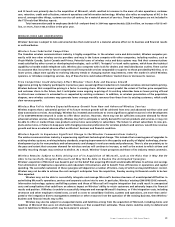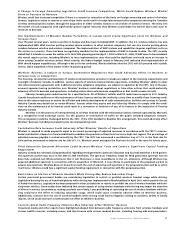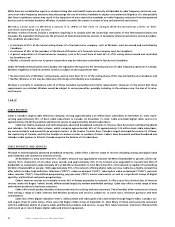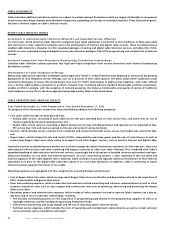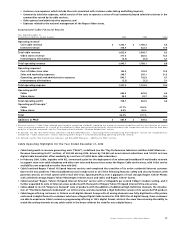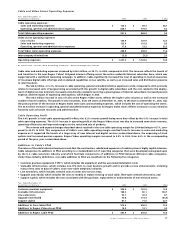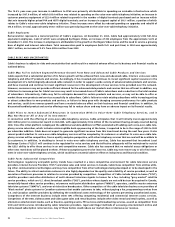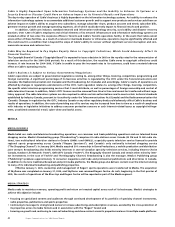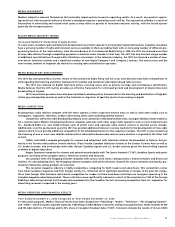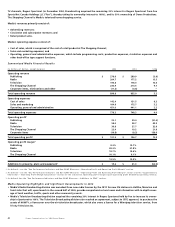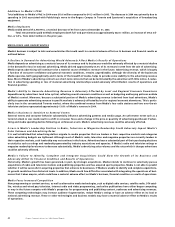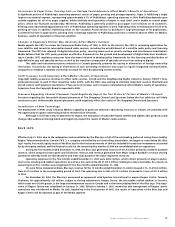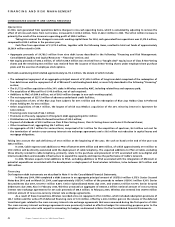Rogers 2004 Annual Report Download - page 41
Download and view the complete annual report
Please find page 41 of the 2004 Rogers annual report below. You can navigate through the pages in the report by either clicking on the pages listed below, or by using the keyword search tool below to find specific information within the annual report.
39
Rogers Communications Inc. 2004 Annual Report
Competition in Multiple Dwelling Unit Buildings Could Lead to Revenue Losses
The CRTC Broadcasting Distribution Regulations do not allow Cable or its competitors to obtain exclusive contracts in buildings where it
is technically feasible to install two or more systems. CRTC winback rules also limit communications with customers in multiple dwelling
unit buildings (“MDUs”) for ninety days after they have switched to a competitive supplier. In addition, there are restrictions on Cable’s
ability to communicate with the residents of an MDU for ninety days after a competitive supplier signs an access agreement to provide
service in the building. Approximately one-third of Cable’s basic cable subscribers are located in MDUs. These regulations and related
policies could lead to competitive subscriber losses or pricing pressure in MDUs serviced by Cable, which could result in a reduction in
its revenue.
Forecasting Additions to PP&E May Become More Difficult, Which May Increase the Volatility of Cable’s Operating
Results
An increasing component of Cable’s additions to PP&E will be to support a series of more advanced services. These services include
Internet, digital television, PVR, HDTV, VOD, SVOD, cable telephony and other enhanced services that require advanced subscriber
equipment. A substantial component of the PP&E required to support these services will be demand driven. For example, increasing per-
subscriber bandwidth usage may lead to increased network costs. As a result, forecasting Cable’s future levels of additions to PP&E will
likely become less precise, which may increase the volatility of Cable’s operating results from period to period.
Increasing Programming Costs Could Adversely Affect Cable’s Results of Operations
Cable’s single most significant purchasing commitment is the total annual cost of acquiring programming. Programming costs have
increased significantly in recent years, particularly in connection with the recent growth in subscriptions to digital specialty channels.
Increasing programming costs within the industry could adversely affect Cable’s operating results if it is unable to pass such program-
ming costs on to its subscribers.
Failure by Programming Suppliers to Continue its Operations May Reduce Cable’s Revenue
There have been a significant number of new digital specialty channels and services that have become available in Canada since the
latter portion of 2001. Cable believes that subscriber selection of these digital specialty service channels, whether individually, in pre-
set theme packs or in customer-designed channel packages, will provide a consistent and growing stream of new revenue. In addition,
the ability to attract subscribers to digital cable service is enhanced by the expanded variety of programming choices that are currently
available, including a growing amount of HDTV and on-demand programming. If a number of programmers that supply digital specialty
channels face financial or operational difficulty sufficient to cause them to cease its operations, and the number of digital specialty
channels decreases significantly, it may have a significant negative impact on Cable’s financial results and financial position.
Reliance on Suppliers
Cable sources its customer premise equipment, certain services and capital builds from certain key suppliers. While Cable has alternate
sources for most of its purchases, the loss of a key supplier could adversely affect the business in the short term.
If Cable is Unable to Develop or Acquire Advanced Encryption Technology to Prevent Unauthorized Access to Cable
Programming, Cable Could Experience a Decline in Revenues
Cable utilizes encryption technology to protect its cable signals from unauthorized access and to control programming access based on
subscription packages. There can be no assurance that Cable will be able to effectively prevent unauthorized decoding of signals in the
future. If Cable is unable to control cable access with its encryption technology, its subscription levels for digital programming includ-
ing VOD and SVOD, as well as Rogers Video rentals, may decline, which could result in a decline in Cable’s revenues.
Cable is Required to Provide Access to its Cable Systems to Third Party ISP’s, Which May Result in Increased
Competition
Cable is required by the CRTC to provide access to its cable systems to third party ISPs at mandated wholesale rates. The CRTC has
approved cost-based rates for third party Internet access service and those rates are currently under review by the CRTC. As a result of
the requirement that Cable provide access to third party ISPs, Cable may experience increased competition for Internet retail subscribers.
In addition, these third party providers would utilize network capacity that Cable could otherwise use for its own retail subscribers.
A third party ISP has connected to Cable’s network on a wholesale basis and is providing competing Internet services at retail.
The increased competition and reduced network capacity could result in a reduction of Cable’s revenue.
Failure to Obtain Access to Support Structures and Municipal Rights of Way Could Increase Cable’s Costs and
Adversely Affect its Business
Cable requires access to support structures and municipal rights of way in order to deploy facilities. Where access to municipal rights of
way cannot be secured, Cable may apply to the CRTC to obtain a right of access under the Telecommunications Act. However, the
Supreme Court of Canada ruled in 2003 that the CRTC does not have the jurisdiction to establish the terms and conditions of access to
the poles of hydroelectric companies. As a result of this decision, the Canadian Cable Telecommunications Association filed an applica-
tion with the Ontario Energy Board (“OEB”) asking it to set a pole rate for all hydroelectric distributors in Ontario. The OEB accepted
jurisdiction over this matter and held a hearing in November 2004. In New Brunswick, where there is currently no similar regulatory
authority, Cable has received notifications from electric distributors that they will be seeking a rate increase for the poles that they
own. As a result, the costs of obtaining access to support structures of hydroelectric companies in each of their cable service areas could
be substantially increased and could adversely affect Cable’s operating results.


